printer friendly version (pdf) - University of Glasgow
printer friendly version (pdf) - University of Glasgow
printer friendly version (pdf) - University of Glasgow
Create successful ePaper yourself
Turn your PDF publications into a flip-book with our unique Google optimized e-Paper software.
ISSN 1754-1514TheBottleImpIssue 13, May 2013The Scottish bagpipe: political andreligious symbolism in Englishliterature and satireVivien WilliamsIf you try typing the word ‘bagpipe’ inGoogle Images, you might be forgiven forassuming the bagpipe world extends littlebeyond Scotland. Out <strong>of</strong> the first fifty images,only two show non-Highland bagpipes. Thisis indeed a culturally interesting detail, sincethere are hundreds <strong>of</strong> different kinds <strong>of</strong> bagpipein the world – from India to Britain, andfrom Libya to Sweden. And yet in Scotland theinstrument has become a national symbol <strong>of</strong>immense importance. The very word ‘bagpipe’oozes Scottishness – as the word Scotlanddoes bagpipes.The nature <strong>of</strong> the images which turn up inthe web search gives us an idea <strong>of</strong> the predominantimagery associated today with theinstrument. To the modern mind, the bagpipeappears to evoke feelings <strong>of</strong> military pride,with images <strong>of</strong> sweeping, lush, wild landscapes,stout kilted men and colourful paradesin swaying tartan. The bagpipe unmistakablyspeaks <strong>of</strong> Scotland, and it has done for centuries.And yet, the terms <strong>of</strong> reference were notalways quite as positive …If we look at non-Scottish early eighteenthcenturysources (mainly literature and prints)featuring bagpipes, we can understand howScotland as a whole was viewed. ThomasBrown, for instance, was a Grub Street satirist,author <strong>of</strong> the work Letters from the Dead tothe Living (1702), consisting <strong>of</strong> invented correspondencebetween well-known characters.Particularly interesting is that between HenryPurcell and John Blow – Baroque organists aswell as friends. From Hell, where Brown relegateshim, Purcell writes to Blow about a number<strong>of</strong> composers, musicians etc., and the lifestylethey and he himself lead in this music-filledHades. Purcell mentions a Doctor Stag—s:Dr. Nicholas Staggins, Master <strong>of</strong> the King’sMusic and Pr<strong>of</strong>essor <strong>of</strong> music at Cambridge. 1According to Purcell, Staggins’ permanence inHell is indeed pleasant, and ‘his Business is tocompose Scotch tunes for Lucifer’s Bag-piper.’ 2Should this not be intriguing enough in itself,Blow comments in his response on the erroneousepitaph on Purcell’s marble stone (whichassigns him a place in Heaven) and the relativity<strong>of</strong> perspectives towards attributed virtue orvice:The Fanaticks especially are very highly <strong>of</strong>fendedat [the epitaph] and say, It looks as if a Man couldToot himself to Heaven upon the Whore <strong>of</strong> Babylon’sBagpipes, and that Religion consists only in the truesetting <strong>of</strong> a Catch, or composing <strong>of</strong> a Madrigal. 3It is interesting that Brown should imagine –or tease his readers into thinking – that noneother than the devil himself should have a personalpiper – not playing just any music, but‘Scotch tunes.’ It is fascinating the way Blowpresents the bagpipe as the lowest step in thehierarchy <strong>of</strong> musical instruments, and how it ischarged with negative religious connotations:the bagpipes represent the most corrupt <strong>version</strong><strong>of</strong> Catholicism; as seen by the ‘Fanaticks.’Contemporary politics, religion and culture hadoutlawed the bagpipes, and pushed them tothe fringe.But Brown’s case is by no means an isolatedone. Edward (‘Ned’) Ward, also a Grub Streetpoet, makes some extraordinary remarksabout bagpipes. 4 His Nuptial Dialogues andDebates were published in 1710; they consist<strong>of</strong> a series <strong>of</strong> conversations on various topicsby different married couples. Particularly, inDialogue XV ‘Between a Dissenting Alderman,and his High-Church Lady’, the Alderman asksthe High-Church lady:Why to St. Paul’s, my Dear? What make you chuseA Church that Jacobites and Papists use,Where English Mass is lyrick’d o’er by Boys,And Popish Bagpipes make a hideous Noise?How can a sober Christian be devoutAmidst such Fa-la-la, and Toot-a-Toot?A Jargon that pr<strong>of</strong>anes the Sabbath-Day,And makes you fitter far to dance, than pray? 5The bagpipes and their music are turned intoa pretext to claim the supremacy <strong>of</strong> one faithover the other. The Anglican faith shares, inthe view <strong>of</strong> the dissenting husband, the traitsattributed to Roman Catholicism – and thereforewww.thebottleimp.org.ukThe Bottle Imp is the ezine <strong>of</strong> the Scottish Writing Exhibition www.scottishwriting.org.ukand is published by the Association for Scottish Literary Studies www.asls.org.uk 1
to Jacobites also, since the Jacobites followedthe Stuart dynasty: a Catholic monarchy. Thehusband responds harshly to his wife’s opinionson the church and bagpipe music: sucha ‘Babylonian Noise’ and ‘Jargon Sound’ is notfit for Church, but rather her ‘Heathen Bagpipes’ should be <strong>of</strong> use in ‘Smithfield Booth, orWapping Musick-house’. 6 He calls them ‘filthy’,‘odious’, ‘noisy Pipes, that do in Brothelsstand’; it is a ‘great Abuse’ to use ‘thosewicked Instruments’, as their ‘Whistles roaraloud in Fairs and Brothels’: the pipes are usedin ‘ill Houses’, and ‘Moorfields Bawdy-houses.’ 7These comments are <strong>of</strong> no small sociologicalconsequence. It would be extremely difficultto find a similar assertion in the works <strong>of</strong> aScottish author; even if the bagpipes are alsoseen in Scotland as an instrument for accompanyingmerriment.The vilifying role <strong>of</strong> ‘Whistles’ is particularlyworthy <strong>of</strong> note. Since Medieval times whistlingwas considered morally inappropriate, especiallyfor women; it is in fact a popular sayingthat ‘A whistling maid and a crowing hen areneither fit for God nor men.’ Ward’s descriptionis suggestive <strong>of</strong> the bagpipe being unsuitablefor receiving the word <strong>of</strong> God: that its soundshould be equalled to a whistle is no coincidence.The ‘ungodliness’ <strong>of</strong> the instrumentis not a trait attributed to Scottish bagpipesalone, as also elsewhere in Europe the bagpipecould (and still can) be seen portrayed – andeven built – with Luciferian characteristics,i.e. in the shape <strong>of</strong> a goat. The goat is one <strong>of</strong>the possible representations <strong>of</strong> the devil, andsince goat’s skin is one <strong>of</strong> the most frequentlyemployed materials for the bag <strong>of</strong> the instrument,the connection is easily made.The bagpipes seem to incarnate the defects<strong>of</strong> the Catholic faith – or rather, they appearto be the perfect means to portray them; theirsymbolism and characteristics are used byboth sides to attack the other. The dissentinghusband explodes in a strong expression:“I’d rather hear the Tower Lyons roar; I tellthee they’re the Bag-pipes <strong>of</strong> the Whore.’ 8 The‘Lyons’ Ward refers to are the ones which usedto be kept in the Tower <strong>of</strong> London, and whichbecame a symbol <strong>of</strong> the Crown: the authority<strong>of</strong> Protestant succession, and as such theemblem <strong>of</strong> the opposition with the Whore <strong>of</strong>Babylon – the Roman Catholic faith. The husbandshows all his wrath and disgust towardsmusic, and particularly towards bagpipes. It isas if the bagpipe were in itself an evil, corruptinstrument, much in the same way as theflute in the song ‘The Old Orange Flute’, whichwould keep playing the tune ‘The ProtestantBoys’ even as it burned in front <strong>of</strong> the Catholicpriests who ordered its destruction. 9 ‘I tell theethey’re the Bag-pipes <strong>of</strong> the Whore’ is a strongstatement which unquestionably links the bagpipesto the Catholic faith.In order to further tighten the bond betweenthe elements <strong>of</strong> what truly appears as a trichotomy– Scotland, Catholicism, and bagpipes– the husband furiously exclaims:Am I possest with an infernal Sprite,You Witch <strong>of</strong> Endor, nay, you Jacobite?[...] I’m a true Low-Church Protestant, and hateTo hear your Pipes, in whose Defence you prate:Their odious Sound shall never take with me;Their very Breath smells strong <strong>of</strong> Popery;And when their Anti-christian Toots I hear,I fancy that the scarlet Whore is near. 10To the dissenter’s eyes, bagpipes are evil tothe extent <strong>of</strong> being anti-Christian. The essence<strong>of</strong> all evil is enshrined in the symbol <strong>of</strong> thebagpipes and their apparatus <strong>of</strong> signifiers. Thedialogue ends with the husband leaving for hisown business, and letting the question dropunsolved.An alternative interpretation <strong>of</strong> the symbolicmeaning and value <strong>of</strong> the bagpipe cannot bealtogether ruled out: the word ‘bagpipe’ mayin fact have been used by the two authors as aderogatory term to identify the organ, whoseconstitutive elements do include a form <strong>of</strong> bag– the bellows – and pipes. Purcell and Blow <strong>of</strong>Brown’s work were organists; and playing theorgan in church is to this day a Catholic tradition;while it is difficult to find references to bagpipesbeing played during services in church.Ned Ward refers to bagpipes being played inbrothels: in his opinion, ‘noisy Pipes, that do inBrothels stand’ have ‘pr<strong>of</strong>an’d’ the Church. Thesexual allegory <strong>of</strong> these references is unmistakable,though one cannot exclude the possibilitythat the author is hinting at the use <strong>of</strong> organs,or also portative organs, which could be transportedeasily – in brothels, churches, or fairs,as Ward suggests. A portative organ was onmany occasions, such as mass, processions orprivate entertainment, a possible alternativeto the better-known church organ (or ‘kist o’whistles’, as it was also known in Scotland, 11whence possibly the reference to the ‘vileunhallow’d Whistles’). Church organs are alsoknown to have ‘found their way’ to taverns andmusic houses during the Commonwealth, 12which may have appeared deplorable to Ward’sangry Low-Church husband.www.thebottleimp.org.ukThe Bottle Imp is the ezine <strong>of</strong> the Scottish Writing Exhibition www.scottishwriting.org.ukand is published by the Association for Scottish Literary Studies www.asls.org.uk 2
Whether Brown and Ward were actuallyreferring to bagpipes all along, or whetherthe term was being employed as a derogatory‘synonym’ for the organ, the connectionwith the Roman Catholic faith is in either caseconfirmed: the bagpipe appears to be theperfect icon to represent popery, and corruptCatholicism.The devil-and-bagpipes dichotomy wasvery much a popular theme when describingScotland even in the late eighteenth century.‘The thistle reel’ is a fascinating engravingpublished in The London Magazine in February1775 (with a dissertation on the theme, called‘The thistle reel: a Vision’). 13 It depicts LordsBute, North and Mansfield dancing around athistle in the shape <strong>of</strong> a Holy Chalice. The thistlebears a garter with the motto honi soit quimal y pense, and in the top right-hand cornera devil plays a set <strong>of</strong> bellows-blown bagpipes.The print satirises the Scottish influence onthe Quebec Bill. The Quebec Act <strong>of</strong> 1774 guaranteedFrench law code, religion and status inthe Canadian region. The smiling devil playingfor the noblemen evidently representsthe legitimisation <strong>of</strong> immorality. The bagpipe,well-established emblem <strong>of</strong> Scottishness, ishandled by no less than the master <strong>of</strong> all evil;it is as if the sound <strong>of</strong> the pipes, the echo <strong>of</strong>Scotland, dominated the situation making theLords dance – commit evil deeds.‘The Mitred Minuet’, dated 1774, is anotherengraving on the topic <strong>of</strong> the Quebec Bill. Thetheme is treated in a very similar way to ‘TheThistle Reel’: 14 four bishops cross hands overa copy <strong>of</strong> the Bill, while three ministers witnessthe scene. Lord Bute, in Highland attire,is playing a set <strong>of</strong> bellows-blown bagpipes – orat least no mouthpiece is discernible. Hoveringover the ministers is, yet again, the devil.It should not surprise us to see that thebagpipes featuring in these prints have verylittle to do with the Scottish (Highland) bagpipeas we know it today. To start with, it isonly recently that stricter categorisations onethnic or national lines have been applied toBritish bagpipes. In the past, classificationsand varieties were much more flexible, andindeed the characteristics <strong>of</strong> each instrumentwere variable. Secondly, and perhaps moreimportantly, many English <strong>printer</strong>s did notnecessarily have in mind a specific model <strong>of</strong> aScottish piper for their depictions. Artists <strong>of</strong>tentook their models from Dutch representations<strong>of</strong> pipers, or from the model <strong>of</strong> the musettede cour, the bellows-inflated bagpipe whichbecame very fashionable in France during theseventeenth century. The accuracy <strong>of</strong> the representation,ultimately, was not so important:essentially all it took was for a bagpipe <strong>of</strong> anyform to be present on the page to convey anidea <strong>of</strong> Scottishness.What emerges from both these images– which are but two <strong>of</strong> a number <strong>of</strong> examples!– is the underlying message that thetendency towards malevolence is an integralpart <strong>of</strong> the national behaviour. Whether thedevil plays the bagpipe to induce the Lordsto dance, or whether he witnesses the sceneas the bagpipe is being played, the instrumentcontributes in creating a bond betweenScotland, religion and politics. The bagpipe’ssound provides the background music for allthings unlawful, corrupt and unacceptable. Itsconnection with Scotland, in the eyes <strong>of</strong> manyan English satirist, is so strong that its merepresence in literature or prints is enough toconvey a plethora <strong>of</strong> signifiers which speak<strong>of</strong> Jacobitism, devotion to the Stuart dynastyand a Catholic monarchy, and the disruptiveeffects this would have on the EnglishEstablishment.The kind <strong>of</strong> diabolical symbolism hithertodescribed took a long time to disappear frompopular imagination. Scots themselves willemploy it; perhaps the most famous exampleis that <strong>of</strong> Robert Burns’ ‘Tam O’ Shanter’,where ‘auld Nick, in shape o’ beast’ was incharge <strong>of</strong> giving music to the dancing spiritsand witches with ‘hornpipes, jigs, strathspeys,and reels’; he ‘screw’d the pipes and gartthem skirl.’ 15 The bagpipe’s diabolic and phallicconnotations found Europe-wide since theMiddle Ages made the instrument a perfectsymbol to represent bawdiness, degeneracy,and debauchery – ‘lascivious practice(s) tooindecent for explanation’, as Francis Groseputs it in his Classical Dictionary <strong>of</strong> the VulgarTongue. 16The fascination for the satanic associationwith the bagpipe is still present to this day,although its connection with Scotland hasweakened enormously. Already by the end <strong>of</strong>the eighteenth century it is almost impossibleto find English works in which the bagpipe isportrayed quite in the same way as it was byWard or Brown. As the threat <strong>of</strong> the Jacobiterebellions was seen to fade, and Scotland wasno longer seen as an enemy, the terms andimagery employed to describe the bagpipetook up s<strong>of</strong>ter terms.The bagpipe’s presence in literature and artdid not stop altogether evoking feelings <strong>of</strong> disquietude:its implications in war and conflictswww.thebottleimp.org.ukThe Bottle Imp is the ezine <strong>of</strong> the Scottish Writing Exhibition www.scottishwriting.org.ukand is published by the Association for Scottish Literary Studies www.asls.org.uk 3
emained discernible well into the nineteenthcentury. In William Wordsworth’s pastoralpoem ‘Michael’, the South wind is described asmaking ‘subterraneous music, like the noise /Of bagpipers on distant Highland hills’. 17 Thesound-quality <strong>of</strong> the rumble <strong>of</strong> distant Highlandbagpipes in the background, especially itsmenacing implications <strong>of</strong> battle and upheaval,is compared with the stormy threat <strong>of</strong> a southwind, the warmth <strong>of</strong> which proverbially bringstempest. The sound <strong>of</strong> the bagpipe is threateningand disquieting; it feels like somethingunavoidable, irrepressible; almost sublime.The icon-bagpipe is so heavily charged that itis not merely pastoral and rustic. It is a disturbingpresence, which reminds the readerthat even the rural haven <strong>of</strong> the Northumbriancountryside <strong>of</strong> the poem is not free from melancholy,disquietude, and mortality.In Childe Harold’s Pilgrimage Lord Byronwrote about the battle <strong>of</strong> Quatre Bras (1815),and how the ‘pibroch thrills, / Savage andshrill’ sounded ‘in the noon <strong>of</strong> Night’, instilling‘The stirring Memory <strong>of</strong> a thousand years,/ And Evan’s – Donald’s fame rings in eachClansman’s ears!’ 18 ‘Evan’ and his successor‘Donald’ are the Camerons <strong>of</strong> Lochiel: Evanfought in the 1715 rebellion, and Donald followedPrince Charles to France after Culloden.The Jacobite rebellions are ever-present inthe author’s mind.The same battle was described by WilliamMakepeace Thackeray in Vanity Fair: the ‘shrillpipes <strong>of</strong> the Scotch’ 19 awakened Brussels, andJos Sedley snoozed ‘in spite <strong>of</strong> all the drums,bugles, and bagpipes <strong>of</strong> the British Army’. 20 Inthe latter instance we can see how the bagpipesare now quite comfortably termed ‘<strong>of</strong>the British Army’ (my italics) – they are nolonger the ‘bagpipes <strong>of</strong> the Whore’. Instead,they are the instrument which marks theproud presence <strong>of</strong> the British Army in battle.The sound <strong>of</strong> the bagpipe enshrines ideas<strong>of</strong> a long-lost past <strong>of</strong> war, conflict, rebellionagainst the Establishment. But as these laterpassages illustrate, the derogatory termshave subsided to make room for a kind <strong>of</strong>discourse which tickles the reader’s imaginationwith the memory <strong>of</strong> Jacobitism, butwhich is altogether free from its burdensomehistoricity. Jacobitism is part <strong>of</strong> a dangerouspast which is no more: it is a concept, whichspeaks <strong>of</strong> loyalty to a lost cause, attachmentto ancient values and traditions, and martialvalour. It has become a world sufficiently distantto be re-evoked, re-shaped and revisitedin an exotic form <strong>of</strong> novel-like imagination.The sound <strong>of</strong> the bagpipe can now safely belistened to and enjoyed, precisely for theideals and values it has come to embody.Many thanks to Hugh Cheape for hissuggestions.Vivien WilliamsEnglish Literature Department<strong>University</strong> <strong>of</strong> <strong>Glasgow</strong>Notes1 Grove’s Dictionary <strong>of</strong> Music and Musicians, ed. EricBlom, George Grove and Denis Stevens (New York: St.Martin’s Press, 2001), s.v. “Staggins, Nicholas”.2 Thomas Brown, ‘Letters from the dead to the living,and from the Living to the Dead, both Serious andComical’, in The Works <strong>of</strong> Thomas Brown, fifth edition(London: Printed for Sam Briscoe, 1719), vol. 2,p. 298.3 Brown, The Works <strong>of</strong> Thomas Brown, p. 300.4 Howard William Troyer, Ned Ward <strong>of</strong> Grub Street(London: Frank and Cass Company Limited, 1968),pp. 3–5.5 Edward Ward, Nuptial Dialogues and Debates: or, anUseful Prospect <strong>of</strong> the Felicities and Discomforts <strong>of</strong>a Married Life, in two volumes (London: printed forC. Hitch et al., 1759) vol. 2, p. 199.6 Smithfield is a locality in London, where cattle andother livestock were sold. The Oxford English Dictionary,prepared by John A. Simpson and Edmund S. C.Weiner (Oxford: Clarendon Press, 1991), s.v. “Smithfield”.7 Ward, Nuptial Dialogues, vol. 2, pp. 202–04.8 Ward, Nuptial Dialogues, vol. 2, p. 204.9 See Matthew John Caldwell Hogart, The Faber Book <strong>of</strong>Ballads (London: Faber & Faber, 1965), pp. 216–17.10 Ward, Nuptial Dialogues, vol. 2, pp. 206–07.11 O.E.D., s.v. “kist”.12 Ge<strong>of</strong>frey Cox, Organ Music in Restoration England(New York: Garland, 1989), vol. 1, pp. 16–17.13 The London Magazine, or Gentleman’s monthly Intelligencer,vol. XLIV (London: Printed for R. Baldwin, February1775), p. 56.14 BM 5228.15 The Poems and Songs <strong>of</strong> Robert Burns, ed. AndrewLang (London: Methuen & Co. Ltd., 1926), p. 441.16 Francis Grose, A Classical Dictionary <strong>of</strong> the Vulgar Tongue(London: Printed for S. Hooper, 1785), s.v. ‘bagpipe,to bagpipe’.17 Wordsworth Poetical Works, ed. Thomas Hutchinson(London: Oxford <strong>University</strong> Press, 1971), p. 104.18 The Complete Poetical Works <strong>of</strong> Byron, ed. Paul ElmerMore (Boston: Houghton Mifflin Company, 1933),p. 39.19 William Makepeace Thackeray, Vanity Fair (London:Oxford <strong>University</strong> Press, 186?), p. 360.20 Thackeray, Vanity Fair, p. 370.ASLSASLS is a registered charity no. SC006535ASLS is supported by Creative Scotlandwww.thebottleimp.org.ukThe Bottle Imp is the ezine <strong>of</strong> the Scottish Writing Exhibition www.scottishwriting.org.ukand is published by the Association for Scottish Literary Studies www.asls.org.uk 4


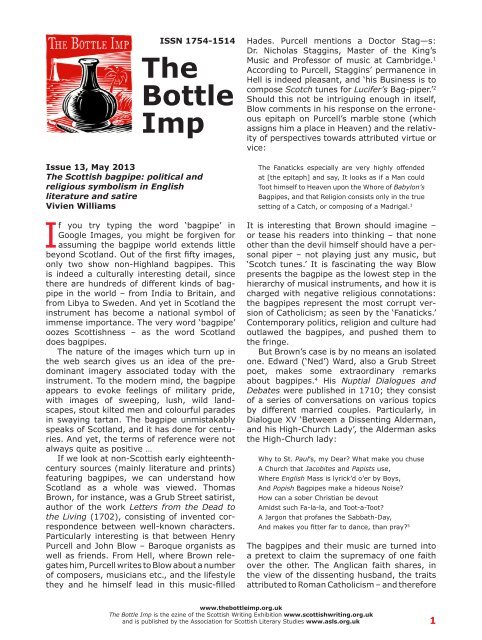
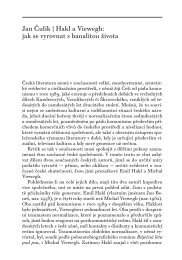

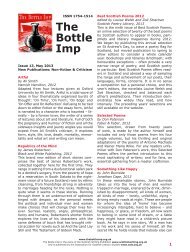
![IPA Index 1 People - E © M K C MacMahon 2007 E, [ ]: 1900.févr ...](https://img.yumpu.com/46502562/1/190x245/ipa-index-1-people-e-ac-m-k-c-macmahon-2007-e-1900facvr-.jpg?quality=85)

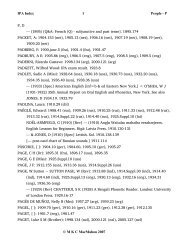

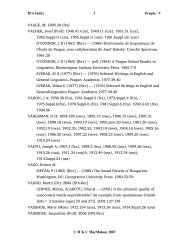

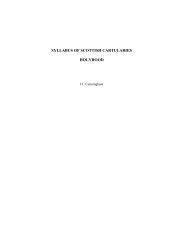
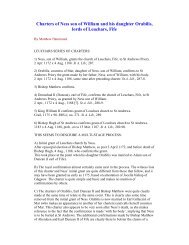

![IPA Index 1 People - D © M K C MacMahon 2007 D, [ ]: 1900.févr ...](https://img.yumpu.com/9908389/1/190x245/ipa-index-1-people-d-c-m-k-c-macmahon-2007-d-1900fevr-.jpg?quality=85)
